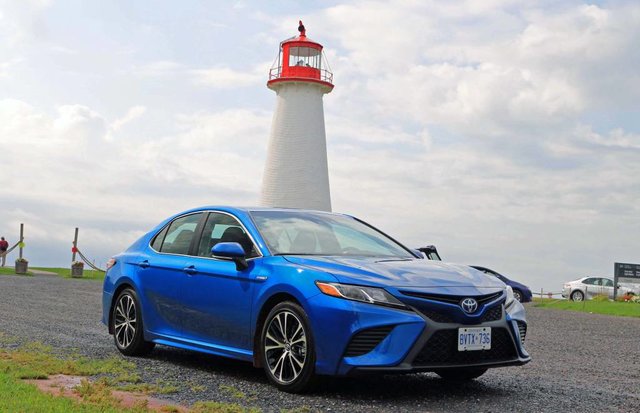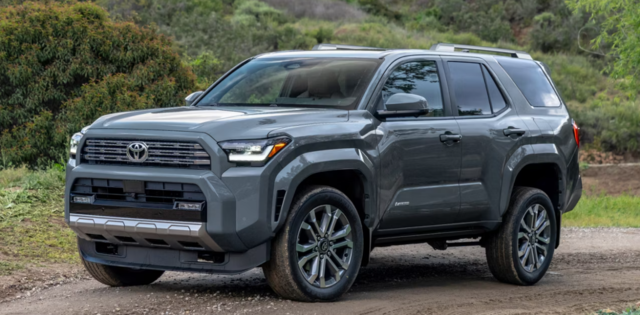The eighth-generation Toyota Camry is all-new and, as noted, it is not your granddad’s car. There are – gasp!– now two-tone paint jobs and a red leather interior, but it is not as gaudy as it sounds. There are also three distinct lines. The “L” line (L, LE, XLE and XLE V6) is more conservative in its style and aimed at the traditional Camry buyer. The “S” line (SE, XSE, XSE V6) is aimed at a younger buyer and, hopefully, one new to the brand. The key differences boil down to the sport suspension and bucket seats along with a body kit. The third model is the next-gen Camry Hybrid.
The basis for the reworked sedan is the Toyota New Global Architecture (TNGA) first used on the new Prius. It is lighter and has a significant 30 per cent increase in torsional rigidity. The car has a 45-millimetre longer wheelbase, it’s 30-mm longer and 25-mm lower. The resulting profile is sleeker and certainly not like the boring box that debuted 35 years ago.
The New Camry arrives with a new 2.5-litre four that pushes 203 horsepower (206 in XSE thanks to the quad exhaust) and 184 pound-feet at 5,000 rpm (186 lb.-ft. for XSE). It works with an all-new eight-speed automatic. The combination is refined and more than up to hauling the Camry around in fine style. It has decent low-end punch and a good mid-range. The plus is that (depending on trim) it is up to 15 per cent more fuel-efficient than the outgoing car.
The up-level engine is a 3.5L V6 that pushes a rewarding 301 hp (which is up 33 hp from before) and 267 lb.-ft. of torque at 4,700 rpm. It adds a great deal of spice to the drive. It is snappy off the line and has a strong upper-mid range. Again, it works with the eight-speed automatic.
The third option is the Hybrid — it uses a retuned version of the base 2.5L engine that runs on the Atkinson cycle. It works with two motor/generators and an electronically-controlled, continuously variable transmission. The latter now has a sport mode with six preselected ratios accessed through paddle shifters. The net system output is rated at 208 hp and 163 lb.-ft. of torque. It gets it juice for a battery of undisclosed size. Interestingly, the base LE Hybrid gets a higher-power lithium-ion battery; the other models use a nickel metal-hydride unit. In both cases, it now sits under the rear seat and so the rear seats now split and fold, unlike the previous model.
The Camry hybrid is an intriguing proposition. It is faster then the base car and it is almost as fast as the V6 in the lower mid-range. The plus is it returns much better fuel economy than either. On the drive loop it returned an average economy of 6.1 litres per 100 kilometres.
All offer different driving modes. Eco makes all feel somewhat flat; Normal is ideal for 90 per cent of the driving time. Sport ramps up the throttle response and stretches out the shift points. It, even in the hybrid, adds a rewarding edge to the driving feel.
Perhaps the biggest change is found in the ride quality. The stiffer chassis, lower centre of gravity and new double wishbone rear suspension combine to improve both ends of the ride/handling equation. In the L series the ride quality is excellent, the steering feel is good and the on-centre feel is crisp.
Shift to the S series and the roll stiffness rises, the anti-roll bars are stiffer and the damping is firmer. The net effect brings a crisper feel with surprisingly little sacrifice in ride quality. It was the preferred setup, as the communication between car and driver is clearer.
The other major rework comes in the cabin. It is now decidedly upscale and features some swanky technology — Toyota’s Entune 3.0 Audio multimedia system. Its abilities vary according to model with 7-inch and up-level 8-inch touch-screens. Both have been integrated into the centre stack such that they look almost iPad-like. The system itself takes direct aim at Apple CarPlay and Android Auto, offering very similar capabilities including the use of an app for navigation — Scout GPS Link. All Camrys come with a three-year subscription. As with CarPlay and Auto, the system uses the phone and its data plan for navigation, so be warned. The mid-range Entune 3.0 Audio Plus adds safety connect (it contacts a call centre in the event of a crunch) and has a stolen vehicle locator. The top-level Entune 3.0 Premium Audio has the lot and its own embedded navigation system.
The rest is very tastefully finished with top-notch soft-touch materials, very comfortable seats and all the mod cons, including a ten-inch head-up display on the high-end units. The impression it leaves is one of luxury — it could very well have been lifted from a Lexus.
Finally, the Camry joins most of the line-up by featuring Toyota Safety Sense P as standard equipment. It uses a radar and camera to provide forward collision avoidance with pedestrian detection. The suite also includes lane departure/keep assist, dynamic cruise control and auto high beams. The nit is that blind spot monitoring with rear cross-traffic alert is not universally standard on Camry — it should be. The lack of a heated steering wheel is equally curious.
The eighth-gen Camry takes some very large steps forward — improved power and economy, significantly better driving dynamics (especially in the S line models) and a truly classy interior. It is, as Toyota went to pains to point out, not your Grandpa’s Camry.
The Camry L has a starting price of $26,390 and the range tops out at $40,990 for the Camry XLE Hybrid.
Source : Graeme Fletcher - Driving.ca - Sprint Marketing





